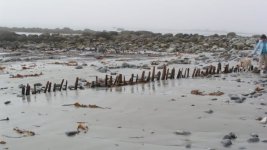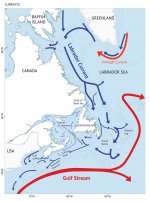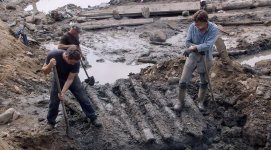You are using an out of date browser. It may not display this or other websites correctly.
You should upgrade or use an alternative browser.
You should upgrade or use an alternative browser.
Oak Island the Strange, the Bizarre, and Maybe the "Truth!
- Thread starter Robot
- Start date
Al D
Bronze Member
You expect people to take you seriously, then you post this, your a joke
etex
Bronze Member
Did the Romans have tar paper?
Robot
Bronze Member
- Mar 10, 2014
- 2,014
- 1,709
- Primary Interest:
- Other
- Thread starter
- #2,344
Who Is The Joker?

https://flixtor.to/watch/movie/26630346/joker
You expect people to take you seriously, then you post this, your a joke

https://flixtor.to/watch/movie/26630346/joker
Last edited:
Al D
Bronze Member
No proof, no evidence, just more BS
Robot
Bronze Member
- Mar 10, 2014
- 2,014
- 1,709
- Primary Interest:
- Other
- Thread starter
- #2,346
There May Be Other Wooden Structures...On Nearby Islands...In Nova Scotia!
Some wooden structures on Hawk Beach NS South of Oak Island...similar to the ones located at Oak Island...also have Archaeologist baffled.

https://www.cbc.ca/news/canada/nova...ture-nova-scotia-archeology-mystery-1.5399667
Some wooden structures on Hawk Beach NS South of Oak Island...similar to the ones located at Oak Island...also have Archaeologist baffled.

https://www.cbc.ca/news/canada/nova...ture-nova-scotia-archeology-mystery-1.5399667
sasquash
Sr. Member
Some wooden structures on Hawk Beach NS South of Oak Island...similar to the ones located at Oak Island...also have Archaeologist baffled.
View attachment 1783806
https://www.cbc.ca/news/canada/nova...ture-nova-scotia-archeology-mystery-1.5399667

Dave Rishar
Silver Member
Does wood rot more slowly in the Atlantic than the Pacific? It's an honest question. We had an awful lot of piers around the Puget Sound 100 or so years ago; they're gone now, and the pilings are not in the greatest of shape today. (The later ones that were treated with creosote are holding up pretty well, but I don't think that creosote was a thing a few centuries ago.) Even the ones that were not treated with creosote (and weren't the result of a pier burning to the waterline) are in roughly the same or better shape than those, and they're only about a century old, give or take.
I'm not going to begin to speculate about the woods used, the water temperatures, bacterial action, etc. I'm simply asking the easy question: does wood in the NE rot like wood in the NW? If it's at all similar, the dating of those structures may not be as old as some think. Generally speaking, even with constant human attention, wood does not last long against the ocean in tidal conditions on the scale of centuries.
I'm not going to begin to speculate about the woods used, the water temperatures, bacterial action, etc. I'm simply asking the easy question: does wood in the NE rot like wood in the NW? If it's at all similar, the dating of those structures may not be as old as some think. Generally speaking, even with constant human attention, wood does not last long against the ocean in tidal conditions on the scale of centuries.
Robot
Bronze Member
- Mar 10, 2014
- 2,014
- 1,709
- Primary Interest:
- Other
- Thread starter
- #2,349
Pass The Salt...Please!
My findings along with some others are that "Salt" acts like a preservative on wood...not only preventing oxygen from interacting with the wood, but also dissuades the Toledo Worms from destroying it.
The Oceans around Oak Island are one of the Saltiest in the World.

https://www.livescience.com/30802-earth-ocean-saltiness-new-map.html
Does wood rot more slowly in the Atlantic than the Pacific? It's an honest question. We had an awful lot of piers around the Puget Sound 100 or so years ago; they're gone now, and the pilings are not in the greatest of shape today. (The later ones that were treated with creosote are holding up pretty well, but I don't think that creosote was a thing a few centuries ago.) Even the ones that were not treated with creosote (and weren't the result of a pier burning to the waterline) are in roughly the same or better shape than those, and they're only about a century old, give or take.
I'm not going to begin to speculate about the woods used, the water temperatures, bacterial action, etc. I'm simply asking the easy question: does wood in the NE rot like wood in the NW? If it's at all similar, the dating of those structures may not be as old as some think. Generally speaking, even with constant human attention, wood does not last long against the ocean in tidal conditions on the scale of centuries.
My findings along with some others are that "Salt" acts like a preservative on wood...not only preventing oxygen from interacting with the wood, but also dissuades the Toledo Worms from destroying it.
The Oceans around Oak Island are one of the Saltiest in the World.

https://www.livescience.com/30802-earth-ocean-saltiness-new-map.html
Last edited:
Dave Rishar
Silver Member
Not in the coastal regions, they're not. Offshore, sure.
Robot
Bronze Member
- Mar 10, 2014
- 2,014
- 1,709
- Primary Interest:
- Other
- Thread starter
- #2,352
Water Water Everywhere...But Not A Drop To Drink...Because It Is Too Darn Salty!
The area around Oak Island are subject to some of the Highest Tidal Shifts...in the World.


With each of the World's Saltiest Gulf Streams meeting at the doorstep of Mahone Bay...these Tides suck all that salty water onto their shores.
Not in the coastal regions, they're not. Offshore, sure.
The area around Oak Island are subject to some of the Highest Tidal Shifts...in the World.


With each of the World's Saltiest Gulf Streams meeting at the doorstep of Mahone Bay...these Tides suck all that salty water onto their shores.
Dave Rishar
Silver Member
The area around Oak Island are subject to some of the Highest Tidal Shifts...in the World.
I've read that the tides in the Bay of Fundy are indeed the largest in the world. However, this isn't the Bay of Fundy. The tides for Mahone Bay appear to be <2m - about half of the tidal shift that we see here at Puget Sound.
With each of the World's Saltiest Gulf Streams meeting at the doorstep of Mahone Bay...these Tides suck all that salty water onto their shores.
I'm not saying that you're wrong or you're right, but the Aquarius salinity map appears to show that the salinity in the area is rather low...roughly equivalent to the Puget Sound. It's also worth noting that the difference between the most saline and least saline water seems to be around 10g/kg. I'm not sure that this would make the difference between pilings lasting for half a century and pilings lasting for multiple centuries.

I'm unconvinced that salinity is a factor here. I'm not saying that there's not some other difference between the northern Pacific and Atlantic oceans that causes a significant change in the rate of deterioration, but I am saying that I've been unable to find one yet.
Last edited:
Robot
Bronze Member
- Mar 10, 2014
- 2,014
- 1,709
- Primary Interest:
- Other
- Thread starter
- #2,354
Here Is Someone...From The Several Billion...Answers...On Oura!
I think the answer you seek depends on the organisms that live in the fresh or salt water, not so much the water itself. In a wooden boat, it is the damp wood above the waterline that rots the fastest, because oxygen that supports fungal and microbial rot is available. In salt water, teredos and other organisms burrow and damage the wood.
Wood that is under water in the absence of oxygen survives for a very long time. A young lady from B.C. has had contract operations in Costa Rica and elsewhere to ‘mine’ the ancient logs that were so dense they sank on the way to mills centuries ago. Gorgeous hardwoods in perfect condition. Wood of quality you cannot get today from living forests.
Robot
I've read that the tides in the Bay of Fundy are indeed the largest in the world. However, this isn't the Bay of Fundy. The tides for Mahone Bay appear to be <2m - about half of the tidal shift that we see here at Puget Sound.
I'm not saying that you're wrong or you're right, but the Aquarius salinity map appears to show that the salinity in the area is rather low...roughly equivalent to the Puget Sound. It's also worth noting that the difference between the most saline and least saline water seems to be around 10g/kg. I'm not sure that this would make the difference between pilings lasting for half a century and pilings lasting for multiple centuries.
View attachment 1784662
I think the answer you seek depends on the organisms that live in the fresh or salt water, not so much the water itself. In a wooden boat, it is the damp wood above the waterline that rots the fastest, because oxygen that supports fungal and microbial rot is available. In salt water, teredos and other organisms burrow and damage the wood.
Wood that is under water in the absence of oxygen survives for a very long time. A young lady from B.C. has had contract operations in Costa Rica and elsewhere to ‘mine’ the ancient logs that were so dense they sank on the way to mills centuries ago. Gorgeous hardwoods in perfect condition. Wood of quality you cannot get today from living forests.
I'm unconvinced that salinity is a factor here. I'm not saying that there's not some other difference between the northern Pacific and Atlantic oceans that causes a significant change in the rate of deterioration, but I am saying that I've been unable to find one yet.
I think the answer you seek depends on the organisms that live in the fresh or salt water, not so much the water itself. In a wooden boat, it is the damp wood above the waterline that rots the fastest, because oxygen that supports fungal and microbial rot is available. In salt water, teredos and other organisms burrow and damage the wood.
Wood that is under water in the absence of oxygen survives for a very long time. A young lady from B.C. has had contract operations in Costa Rica and elsewhere to ‘mine’ the ancient logs that were so dense they sank on the way to mills centuries ago. Gorgeous hardwoods in perfect condition. Wood of quality you cannot get today from living forests.
Robot
Dave Rishar
Silver Member
I think the answer you seek depends on the organisms that live in the fresh or salt water, not so much the water itself. In a wooden boat, it is the damp wood above the waterline that rots the fastest, because oxygen that supports fungal and microbial rot is available. In salt water, teredos and other organisms burrow and damage the wood.
Wood that is under water in the absence of oxygen survives for a very long time. A young lady from B.C. has had contract operations in Costa Rica and elsewhere to ‘mine’ the ancient logs that were so dense they sank on the way to mills centuries ago. Gorgeous hardwoods in perfect condition. Wood of quality you cannot get today from living forests.
Agreed. We have something of an industry like that around here, people dredging up logs from the turn of last century. We won't see wood like that from live forests for a few hundred years. It's hard to believe how long wood can last when it's kept submerged, and how quickly such wood degrades when it's allowed to dry out. I've read that this is a very real problem when historic shipwrecks are recovered - they have to spray them with salt water to keep them wet until they can chemically treat them, and there's some other stuff that has to happen.
That's not what we're talking about in this case though:
This gets wet and then it dries out, and then it gets wet again...like our rotted out piers out here in the Sound, which don't last that long. (Unless treated with creosote, anyway.)
Robot
Bronze Member
- Mar 10, 2014
- 2,014
- 1,709
- Primary Interest:
- Other
- Thread starter
- #2,356
Top TV Series...Again!...Believers...Just Can't Get Enough of...This Show!
A steady outing put “Curse of Oak Island” at the top of the Tuesday cable ratings this week.

Top 25 original cable shows among adults 18-49 for Tuesday, January 21, 2020
A steady outing put “Curse of Oak Island” at the top of the Tuesday cable ratings this week.

Top 25 original cable shows among adults 18-49 for Tuesday, January 21, 2020
| Show | Net | Time | Total viewers (000s) | 18-49 rating |
| CURSE OF OAK ISLAND | HISTORY | 9:00 PM | 3,263 | 0.7 |
Robot
Bronze Member
- Mar 10, 2014
- 2,014
- 1,709
- Primary Interest:
- Other
- Thread starter
- #2,357
“What Is The Measure Of A Man?”...Better Yet…What Is The Unit Measure Of A Man?

Similar to my post #1574
It is Strange...that many finds on Oak Island...May have been ignored of a very important Clue!
The Logs and Wrought Iron Spikes are just a few items, that may have left their Finger Prints as Evidence as to “Where these Culprits were from, Who these Depositors may have been, and When these Freemasons were there”.


If I designed and built a deck in North America, it would be in Imperial Measurements... whereas a deck in Europe or Australia would be in Metric.
From these deck's measurements it could be possible to show where and who might have built it.
The same could be said for the Engineered Projects found in Smith’s Cove.
What was the measurement used for these massive undertakings?

If these Measurements used were prior to the 19[SUP]th[/SUP] Century's change to the Metric System then the time and country of origin may be possible to identify!
England - Ell = 45 imperial inches
Scotland - Ell = 37.06 imperial inches
France - Pied Du Roi = 12.79 imperial inches
Spain - Vara = 32.91 imperial inches
South America - Vara = 34.1 imperial inches
Portugal - Vara = 43.5 imperial inches

Similar to my post #1574
It is Strange...that many finds on Oak Island...May have been ignored of a very important Clue!
The Logs and Wrought Iron Spikes are just a few items, that may have left their Finger Prints as Evidence as to “Where these Culprits were from, Who these Depositors may have been, and When these Freemasons were there”.


If I designed and built a deck in North America, it would be in Imperial Measurements... whereas a deck in Europe or Australia would be in Metric.
From these deck's measurements it could be possible to show where and who might have built it.
The same could be said for the Engineered Projects found in Smith’s Cove.
What was the measurement used for these massive undertakings?

If these Measurements used were prior to the 19[SUP]th[/SUP] Century's change to the Metric System then the time and country of origin may be possible to identify!
England - Ell = 45 imperial inches
Scotland - Ell = 37.06 imperial inches
France - Pied Du Roi = 12.79 imperial inches
Spain - Vara = 32.91 imperial inches
South America - Vara = 34.1 imperial inches
Portugal - Vara = 43.5 imperial inches
ECS
Banned
Those logs appear to be a cordoury road that were common in Nova Scotia during the 19th century....
The Logs and Wrought Iron Spikes are just a few items, that may have left their Finger Prints as Evidence as to “Where these Culprits were from, Who these Depositors may have been, and When these Freemasons were there”.
View attachment 1794523
View attachment 1794524
No Templars or Freemasons were involved in their construction.
Robot
Bronze Member
- Mar 10, 2014
- 2,014
- 1,709
- Primary Interest:
- Other
- Thread starter
- #2,359
Appearances Can Be Deceiving!

What proof do you have to make such a statement!
``A proof is sufficient evidence or a sufficient argument for the truth of a proposition. The concept applies in a variety of disciplines, with both the nature of the evidence or justification and the criteria for sufficiency being area-dependent.``
Those logs appear to be a cordoury road that were common in Nova Scotia during the 19th century.
No Templars or Freemasons were involved in their construction.

What proof do you have to make such a statement!
``A proof is sufficient evidence or a sufficient argument for the truth of a proposition. The concept applies in a variety of disciplines, with both the nature of the evidence or justification and the criteria for sufficiency being area-dependent.``
ECS
Banned
View attachment 1794967
What proof do you have to make such a statement!
``A proof is sufficient evidence or a sufficient argument for the truth of a proposition. The concept applies in a variety of disciplines, with both the nature of the evidence or justification and the criteria for sufficiency being area-dependent.``
A very simple Google search of cordoury log roads in Nova Scotia will provide you with sufficient evidential proof of my statement.
*NOTE* many of those sites contain photos.
Top Member Reactions
-
 2410
2410 -
 1121
1121 -
 1119
1119 -
 908
908 -
 823
823 -
 807
807 -
 763
763 -
 725
725 -
 644
644 -
 522
522 -
 478
478 -
 466
466 -
 457
457 -
 429
429 -
 410
410 -
 406
406 -
O
369
-
 362
362 -
 358
358 -
 352
352
Users who are viewing this thread
Total: 3 (members: 0, guests: 3)
Latest Discussions
-
Recent finds - Large Cents, Jaw Harp, Cufflink, Buckle and Buttons
- Latest: Steve in PA
-
-





